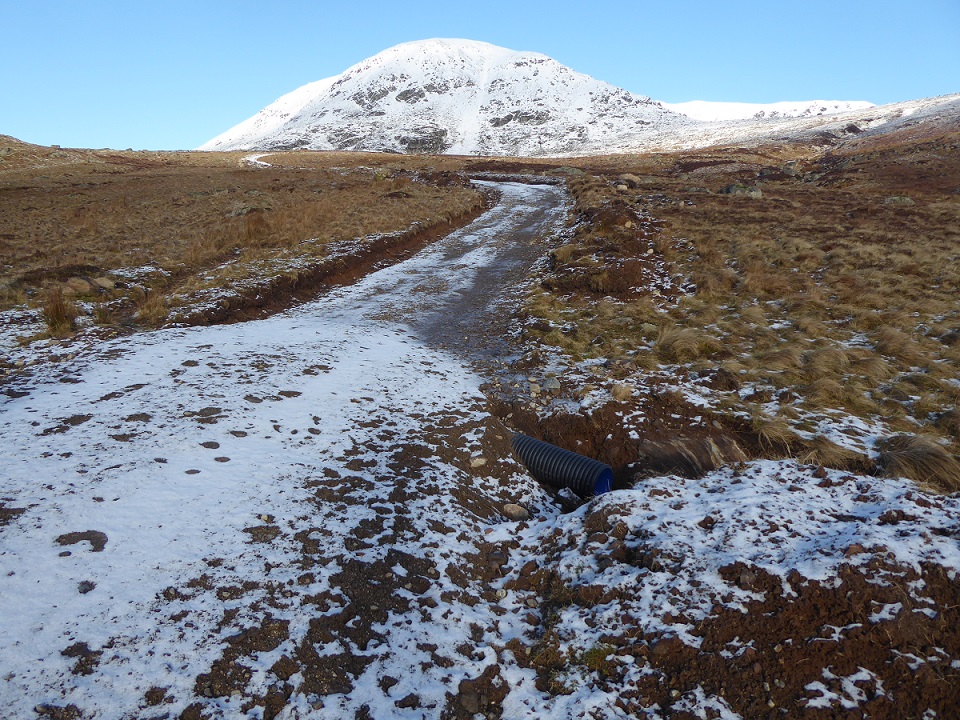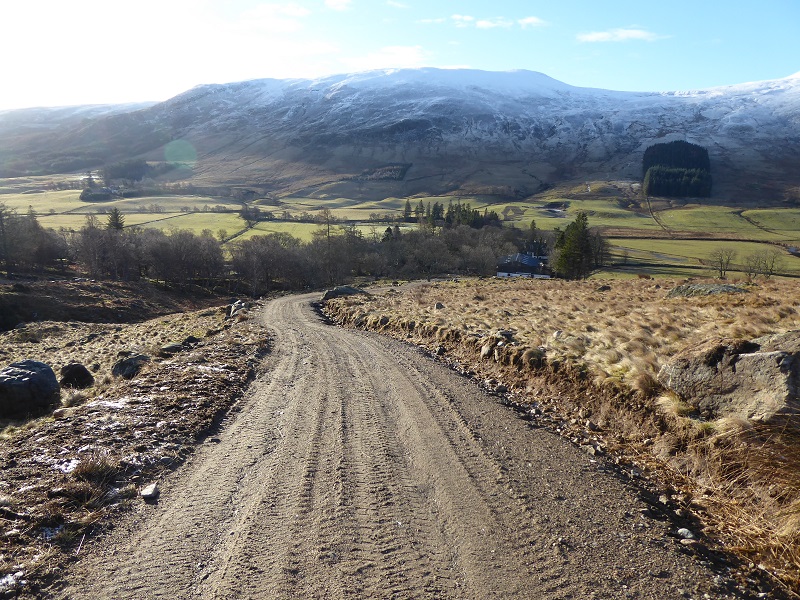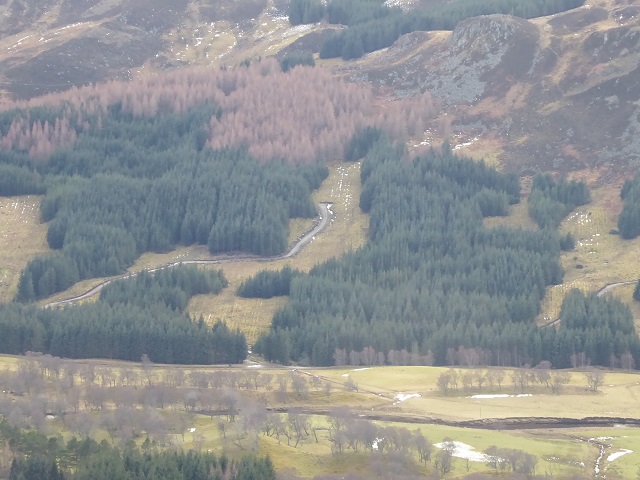While Parkswatch has been critical of the Cairngorms National Park Authority’s failure to control Highlands and Islands Enterprise at Cairn Gorm, it has been doing far better in Glen Clova. The two most recent meetings of the Planning Committee have been rightly criticised for approving the planning applications to repair the funicular and install car park barriers and tube slides in the Coire Cas car park without any masterplan (for video of discussion on last two applications see here). They also, however, approved two applications for hill roads in Glen Clova, which serve to restore the National Park’s authority there.
Both planning applications were from the Glen Clova estate and are a consequence of the enforcement action the CNPA took against the new road above the Glen Clova hotel Together, they show that it is possible to use the planning system to control hill roads and restore some of the damage they have done to the landscape, although fundamental issues do remain.
The CNPA’s victory against the Glen Clova hotel track enforcement appeal

I had intended to blog about the Scottish Government Reporter’s decision in this appeal by the Glen Clova Estate in mid-March (see here for background) but got swept up in the corona crisis. The decision is worth reading in full for anyone interested in the nitty gritty of the law (see here). It upholds the decision by the CNPA that the upper section of this road did not have the necessary planning consents and should be removed.
The decision represents a significant victory for all those concerned about the unregulated proliferation of roads in our hills. The message to landowners and land managers that if they flout the law and don’t secure the necessary planning consents, they may have to restore the ground and face very large bills. It may be cheap and easy to construct a road, but restoration is far more complex and costly.
Just how effective that restoration will be, remains to be seen. The Reporter agreed it was reasonable to require the Glen Clova Estate to complete the work within a year but clarified that it was the “engineering operations that in my view constitute the breach of planning control. It follows the actions should not exceed those required to negate the impact of those engineering operations on the land in question”. What this means is that any ground that was damaged by vehicles prior to the engineering works does not need to be restored to a pristine state. While understandable from a legal viewpoint, that creates a lot of room for the estate to argue with the CNPA about the scope of the restoration works.
The Reporter also amended the CNPA’s proposed condition that vehicles should not be driven in the area for three years to enable the land to recover. The condition now only applies to the strip of ground that is to be restored. The reasoning for this (para 41) is important:
“whilst I appreciate the objective of the Park Authority in seeking to restrict access over the land subject to the notice for a period of three years, I am concerned this impacts on the access rights of the owner and goes beyond the steps which are necessary to address the breach. As currently worded the appellant would be in breach of the notice if he were to take vehicular access over this land at any point in the following three years”.
By access rights, the Reporter is referring to the right of owners to drive vehicles over their land. This illustrates the fundamental problem that still requires to be resolved. Except on Sites of Special Scientific Interests, where driving a vehicle may be on “operation requiring consent”, or on land covered by other legal agreements, landowners can drive where they want. Wherever that causes damage to the ground, landowners can then use that damage to justify construction of a new road as a means of preventing further damage, i.e forcing Planning Authorities to choose between two evils.
There is nothing now to stop the Glen Clova Estate driving vehicles up and down a line parallel to this road which they are being forced to restore until so much damage is caused that the CNPA is left with little choice but to agree a new road. Because of this, if the Glen Clova Estate had applied for retrospective planning permission for the road, as requested by the the CNPA, they would almost certainly have received it as long as they had been prepared to restore some of the damage. This proves that, on its own, the planning system cannot stop the proliferation of hill roads outwith certain specific areas, all it can do is influence their design.
The answer to this problem in National Parks is for our National Park Authorities, which have a statutory duty to put conservation first, to use their conservation bye-law making powers to control all off-road vehicle use. If byelaws made it an offence to cause serious damage to the ground, no landowner would be able to get a new road by arguing this was the lesser of two evils.
The new Glen Clova forest roads
In May, the CNPA Planning Committee granted “approval” to an “application” for 1.6 km of new/upgraded forest road in the Caddam Plantation that had been submitted (see here) from the previously unco-operative Glen Clova estate. It is significant that the “application” was called in and considered by the full Planning Committee as forestry roads count as permitted developments and cannot be refused as such. It appears to be a demonstration of the CNPA’s determination that the Glen Clova and other estates observe due process. It may also represent a welcome turnaround by the estate’s owner, Hugh Niven.
It was also positive that the conditions approved by the Planning Committee (see here for Committee Report) require the new and upgraded road to be no more than 3.5m wide. While there is a debate to be had about what size of machinery is appropriate in a National Park, this is half the width of the forest roads given the nod in the Loch Lomond and Trossachs National Park under the UK Forestry Standard (see here).
The planning application for the lower part of the Clova Hotel hill road

A few days before the Reporter issued their decision, the Glen Clova estate submitted another planning application, this time retrospective, for the lower part of hill road. This section of the road had not been part of the planning enforcement because the CNPA accepted that it had existed for about ten years (during which period it had failed to take appropriate enforcement action within 4 years as required by the law). The road had, however, been upgraded more recently, apparently at the same time the upper road was created, and to a very poor standard. The retrospective application is an acknowledgement by the Glen Clova estate that it should have sought permission for the upgrading work as well as the new road.
The CNPA has used the application to mitigate the damage caused by its construction and upgrading. Essentially, the conditions that the Committee approved require the Glen Clova Estate to narrow the road to 2m with a grass strip down the middle and to restore the damaged ground and culverts on either side. The conditions are again very welcome and show that many of the roads being approved at present, including those to hydro schemes in the Loch Lomond and Trossachs National Park (2.5 to 3m), are far broader than they need be. Wider roads create unnecessary landscape impacts and increase water run-off from the hill. A 2m road with a grass strip down the middle sets a very welcome precedent.
The case also show that if our National Park Authorities used the planning system to maintain tight control over hill road maintenance and upgrades, they could use their planning powers to restore some of the damage that has been caused by poorly constructed hill roads. Poor construction means most roads inevitably require work done on them and that provides an opportunity for our National Parks as Planning Authorities to intervene.
The wider context and implications
While it appears the CNPA has been winning its battle to bring the Clova Estate hill roads into the planning system, a number remain. Some were constructed before agricultural and forest tracks needed any form of planning approval but there are a couple where enforcement action might still be possible.

While the CNPA has in the past two years forced Glen Clova and a couple of other estates to make retrospective Planning Applications for unlawful hill roads, there are other estates, such as at nearby Glen Prosen, where there appears to have been no progress (see here).
All the time, the four year window the CNPA has to take enforcement actions passes. For a number of the roads that have been featured on parkswatch, it is now too late. The best we can hope for in these cases is that if the road needs to be “upgraded” at some point in the future, the CNPA will use the opportunity to mitigate the worst landscape impacts, following the example of the lower hill road in Glen Clova.
The challenge is that even if the CNPA manages to monitor estates more effectively through satellite maps – and it is not clear they have the capability to do that yet – enforcement under the current planning system is very labour intensive and consumes resources. It is a system designed to benefit landowners and developers rather than the public interest. The hope is that having taken successful enforcement action at Glen Clova, the costs of ignoring the planning system entirely will provide an incentive to landowners to put developments through the planning system.
This, in itself, is unlikely to stop new hill roads being constructed because, unless our National Parks bring ATV use under control, the best the planning system can do is to influence the design of hill roads, not whether they exist or not. ATV use or the threat of it will continually undermine the CNPA’s stated policy presumption against new hill roads However, the risk to landowners of simply bulldozing a road and seeking retrospective planning permission afterwards, is that the costs of bringing that road up to CNPA standards could still be considerable. That is why the CNPA’s decision to narrow the lower Clova Hotel hill road to 2m is so important.
